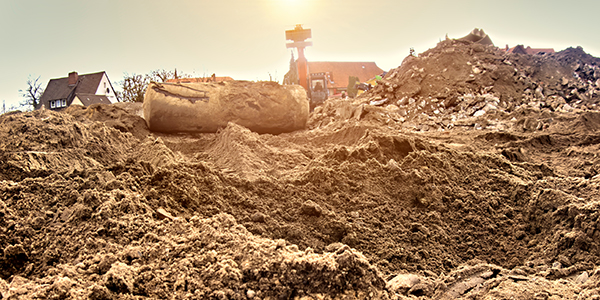
15 May Remediation of Multiple Underground Storage Tanks at a Residential Property
Reading Time: 2 minutesThe following cautionary tale highlights the importance of conducting proper due diligence on residential properties prior to purchase.
ESA was retained to conduct underground storage tank (UST) removal and New Jersey Department of Environmental Protection (NJDEP) closure of three USTs located at a residential property located in Hunterdon County. The USTs were discovered using Ground Penetrating Radar (GPR) methods that were performed as part of a prospective property transaction. One of the USTs is suspected to be associated with a former on-site heating oil consumption based on size and location adjacent to a garage structure. The other two USTs are suspected to be associated with former gasoline filling station operations based on their location near the road, evidence of former fuel dispensers, and review of historical aerial photographs.
Upon removal of the heating oil UST, a fourth UST containing gasoline was discovered, which is suspected to have been used for fueling on-site farming equipment and vehicles. All four USTs displayed evidence of discharges via observed corrosion holes, stained soil, and/or petroleum odors. Based on these observations, the municipal inspector failed the UST inspections and discharges were reported to the NJDEP. Because three of the USTs contained gasoline and are considered regulated, they warranted proper NJDEP Closure and issuance of a Response Action Outcome (RAO) by a Licensed Site Remediation Professional (LSRP) to administratively close the case.
At one of the UST locations, ESA conducted Site Investigation (SI), Remedial Investigation (RI), and Remedial Action (RA) activities via soil excavation, off-site disposal, and confirmatory post-excavation sampling to remediate soils containing concentrations of Volatile Organic Compounds (VOCs) that exceeded NJDEP Soil Remediation Standards (SRS). Due to the presence of shallow bedrock underlying contaminated soil, a ground water bedrock investigation was conducted via sampling of a monitoring well installed utilizing a combination of hollow stem augers and air rotary drilling methods. The laboratory reported concentrations of VOCs below the NJDEP Ground Water Quality Standards (GWQS) and Vapor Intrusion Ground Water Screening Levels (VIGWSL) including low level 1,2-dibromoethane (1,2-DBE) and 1,2-dichloroethane (1,2-DCE) for leaded gasoline in the ground water samples collected from the well, which resulted in the finding that ground water was not contaminated.
At two of the UST locations, soil concentrations of VOCs exceeded NJDEP SRS; however, Synthetic Precipitation Leaching Procedure (SPLP) laboratory analysis was utilized to demonstrate that contaminants were not impacting and not likely to impact ground water – this finding obviated additional investigation and remediation, reducing project costs and schedule.
An additional unexpected challenge was encountered when the laboratory reported concentrations of select Polycyclic Aromatic Hydrocarbons (PAHs) exceeding NJDEP SRS in select UST closure soil samples; specifically, Naphthalene and 2-Methylnaphthalene; the PAHs were reported as non-targeted VOC Tentatively Identified Compounds (TICs) – this finding indicates that the USTs formerly contained diesel fuel at some point in time. Therefore, ESA conducted re-sampling of the UST closure soil samples with analysis of Naphthalene and 2-Methylnaphthalene as targeted compounds. The re-sampling was strategically coordinated in conjunction with the RI activities to avoid an additional mobilization, reducing projects costs and schedule. The sample PAH concentrations were reported below NJDEP SRS.
Successful coordination and execution of this unusual residential project led to municipal permit closure and LSRP issuance of an AOC-specific Unrestricted Use RAO, which administratively closed the NJDEP case and facilitated the sale of the property.



